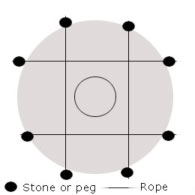 Caring For Your Yurthow to Look after your yurtCanvas Care and ProofingProper care ensures your canvas remains durable and effective over time. The waterproofing applied during manufacturing gradually diminishes with use. To maintain its performance and longevity, we recommend reproofing your canvas annually using Nikwax Tent and Gear SolarProof. This will help protect the fabric and extend its lifespan.
Cleaning the CanvasTo protect your canvas and its proofing, avoid using detergents as they can strip away the waterproofing. Never clean with high-pressure water, as this can also damage the proofing. For discoloration or general cleaning, use Nikwax Tech Wash to gently restore your canvas while preserving its protective properties.
Woodwork MaintenanceOver time, the exterior woodwork may require a new top coat to maintain its finish. Use a high-quality, water-based matte varnish for best results. The chestnut frame, however, is naturally durable and will seldom need additional treatment.
Metalwork/Rings/Door Furniture The door hardware and rings are designed to develop a natural patina over time, mimicking the character of decades-old metal. Initially, you may notice slight signs of oxidation. To address this, we provide a small bottle of oil that transforms the oxidation into a beautiful patina. Simply apply a small amount of the oil to the metal, allow it to dry, and enjoy the evolving finish.
The door hardware and rings are designed to develop a natural patina over time, mimicking the character of decades-old metal. Initially, you may notice slight signs of oxidation. To address this, we provide a small bottle of oil that transforms the oxidation into a beautiful patina. Simply apply a small amount of the oil to the metal, allow it to dry, and enjoy the evolving finish.
Storing Your YurtThe canvas, made from 50% cotton, is rot-proofed but still vulnerable to mold and rot if stored improperly for extended periods. If your yurt is not in use, we recommend dismantling it and ensuring the canvas is completely dry before storage. The felt should also be thoroughly dried—either in the sun or in a warm room—before being stored in a dry, well-ventilated location. Proper storage will help preserve your yurt’s condition and longevity.
Bad Weather PrecautionsIn storms, take the following precautions to protect your yurt:
 Understanding New CanvasBrand new yurt covers may leak. This might seem odd as the material is proofed for water at the factory but the material has to go through a process known as "weathering in". The leakage is, in general, hardly noticeable. It goes like this when the canvas gets wet the fibres expand and fill the gaps in the fresh dry weave of the fabric. All canvas is like this. As the fibres expand and as the gaps shrink the canvas becomes waterproof. The more expansion the smaller the gaps in between the fibres and the more watertight the canvas becomes. All this can take some time. The seams which are double stitched also need to weather in. The needle punches small holes in the canvas and these holes also get filled by the double action of the cotton thread expanding and the weave of the canvas expanding. The canvas usually weather's faster than the seams. After a couple of heavy soakings (and dryings) the canvas should be fully watertight. The seams can take a bit more time as the holes are slightly bigger than the thread so more expansion has to take place. It is not enough for the canvas just to get a good soaking. It needs to completely dry too. So one soaking is not usually enough, it needs to be absolutely dry and then another soaking then to dry again. If you new canvas has some small leaks then this is almost certainly why and most of the time this will go unnoticed and after two or three wettings the canvas is completely weathered in and waterproof. In the rare event when too many drops are coming in then spray the canvas with Nikwax Tent and Gear Proof. Follow the instructions on the bottle and this will immediately slow the leaking to a standstill. This product is best applied on to wet canvas so there is no need to wait for a dry day. Please Note: poly-cotton canvas will shrink slightly after exposure to rain or moisture. This is a natural process, and we account for this in the design by cutting the covers to allow for expected shrinkage. |
||||||||
|
||||||||
